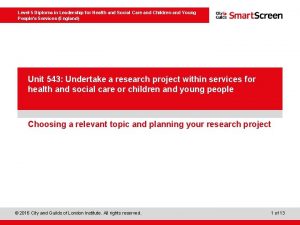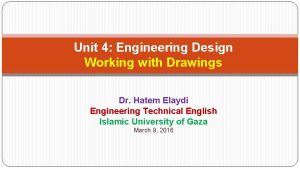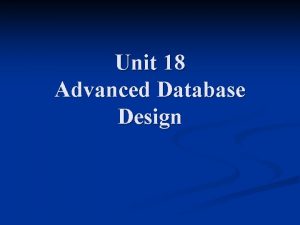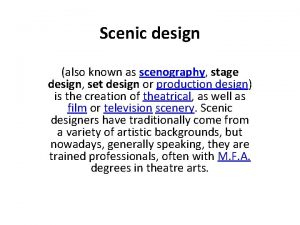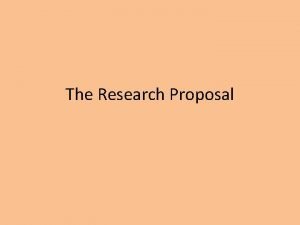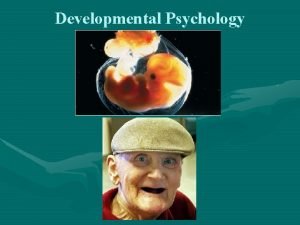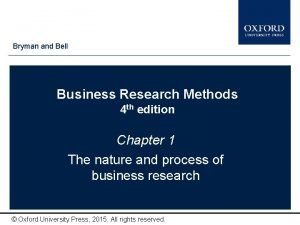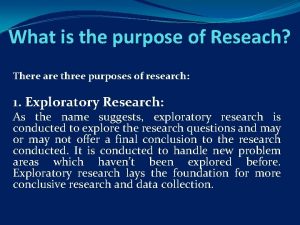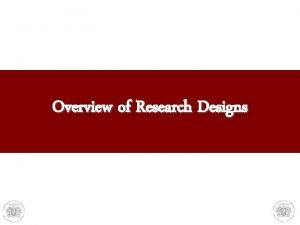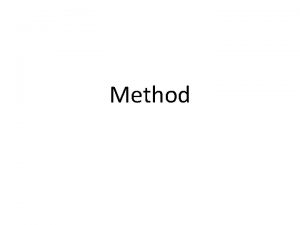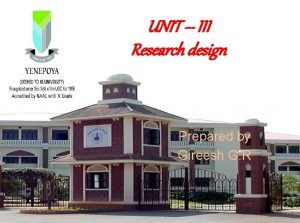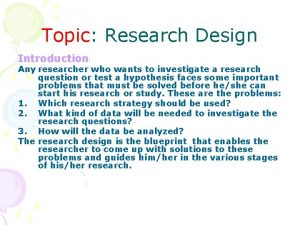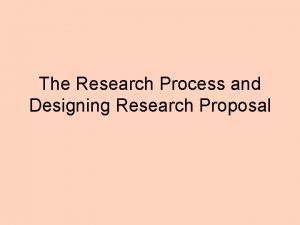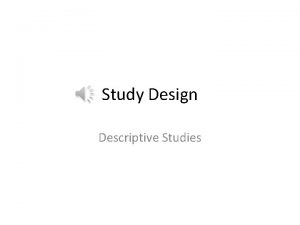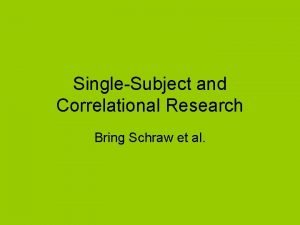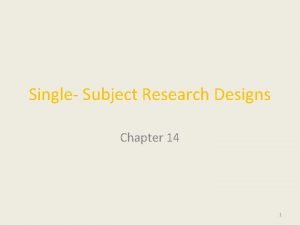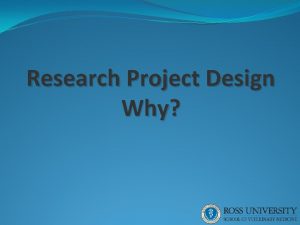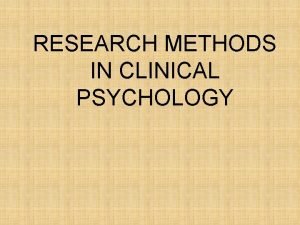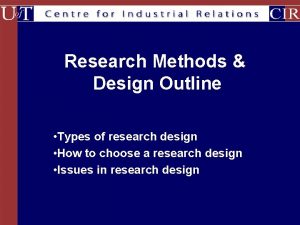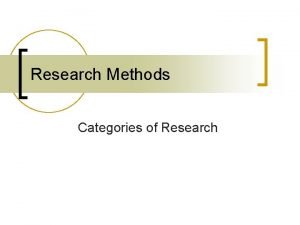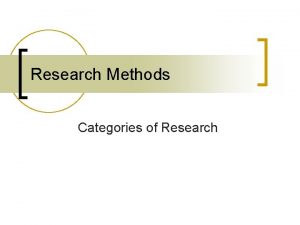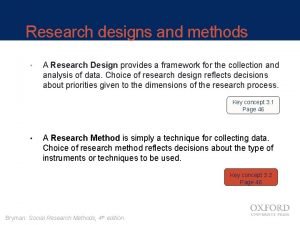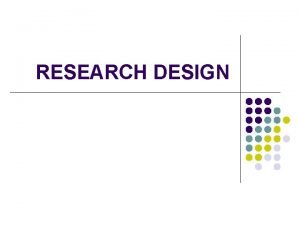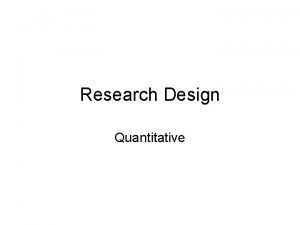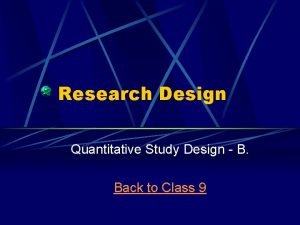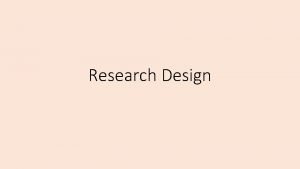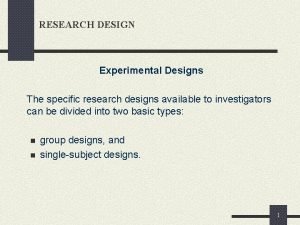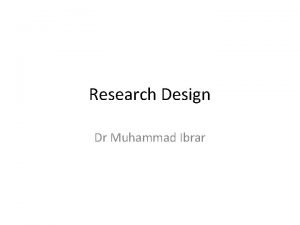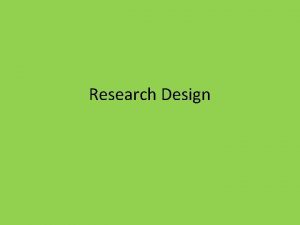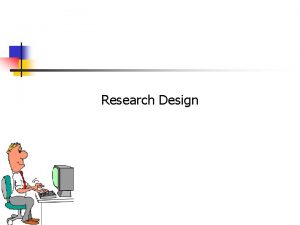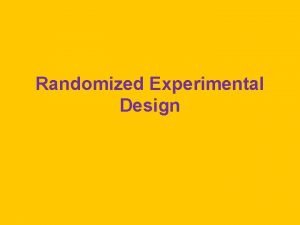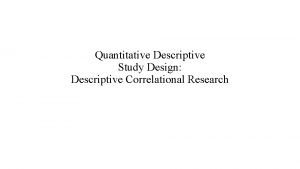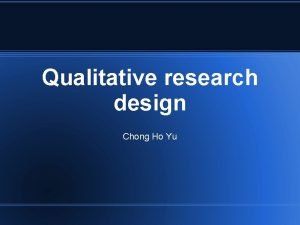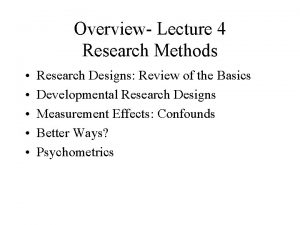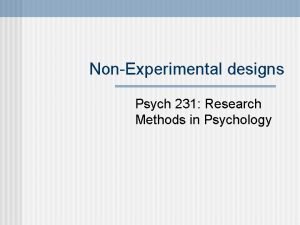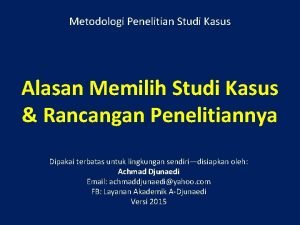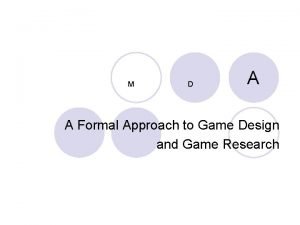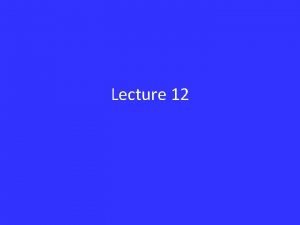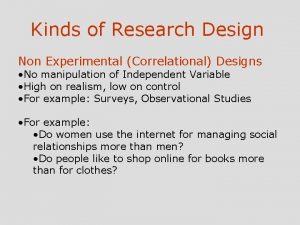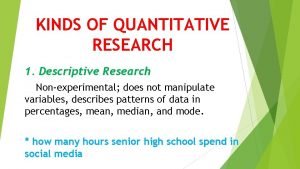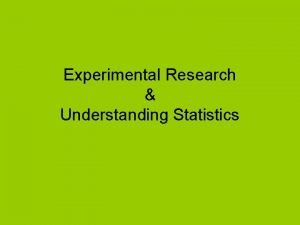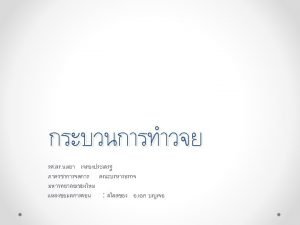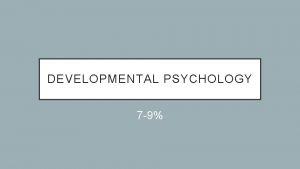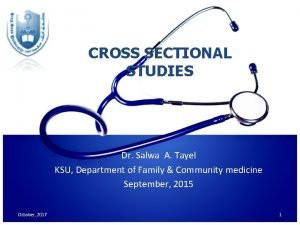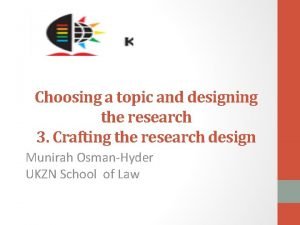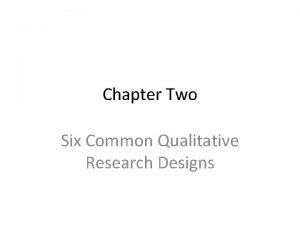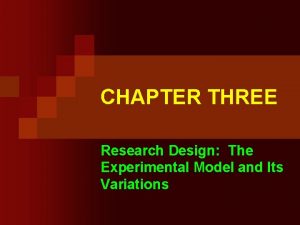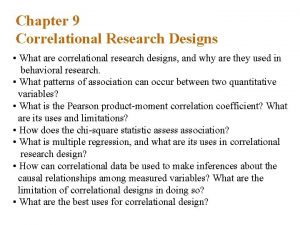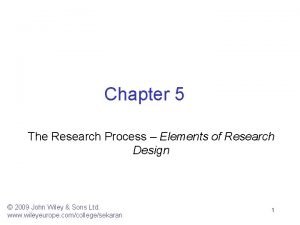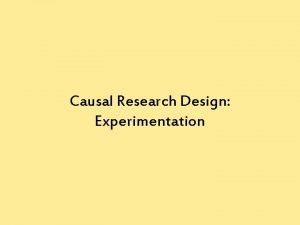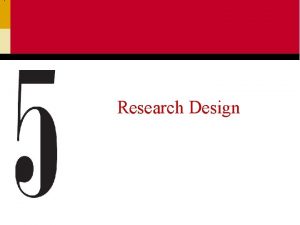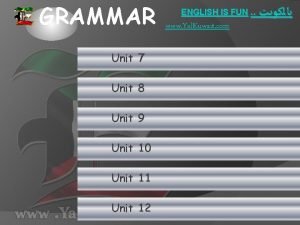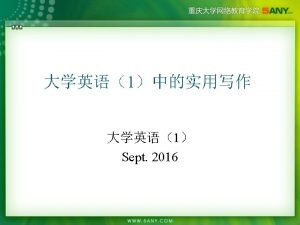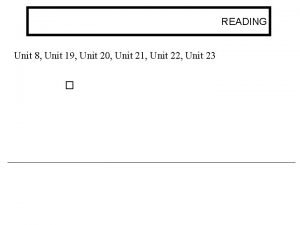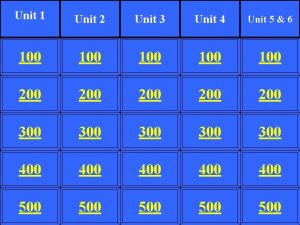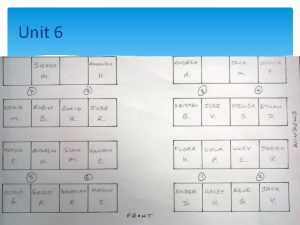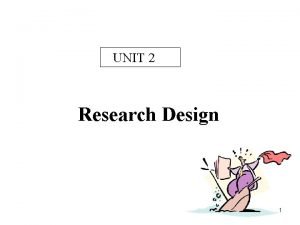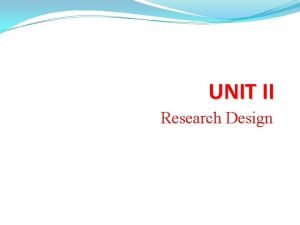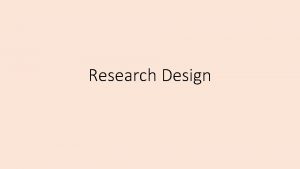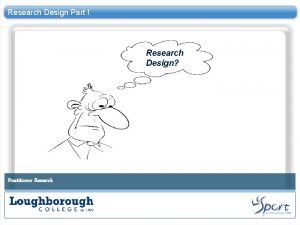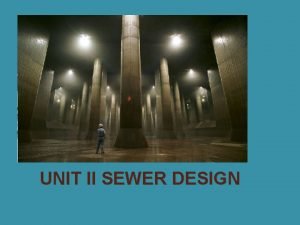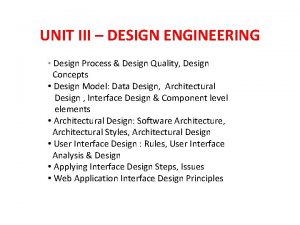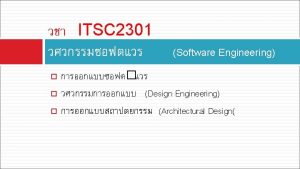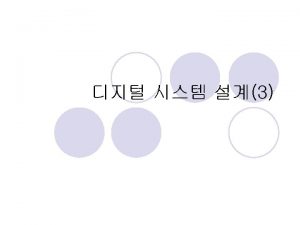Unit IV Research Design RESEARCH DESIGN 2 Research


























































































- Slides: 90

Unit IV Research Design

RESEARCH DESIGN 2

Research Design • A research design is a framework or blueprint for conducting the research project.

What Is Research Design? Blueprint Plan Guide Framework 6 -4

What is Research Design? • A research design is the strategy for a study and the plan by which the strategy is to be carried out. It specifies the methods and procedures for the collection, measurement, and analysis of data. • It is a plan for selecting the sources and types of information used to answer research questions • It is a framework for specifying the relationships among the study variables • It is a blueprint that outlines each procedure from the hypothesis to the analysis

Elements of Research Design Research Approach (Qual, Quant) Measurement and Operationalization Study Setting 6 -6 Purpose (Explore, describe, relationship) Elements of Research Design Data Analysis Methods Data Collection Method Data Analysis Methods Time Dimension

A Classification of Types of Research Designs Research Design Conclusive Research Design Exploratory Research Design Descriptive Research Cross-Sectional Design Causal Research Longitudinal Design Panel Study Trend Study

Uncertainty Influences the Type of Research COMPLET E CERTAIN TY NO RESEARCH AT ALL UNCERTAIN TY CAUSAL RESEARCH ABSOLUT E AMBIGUI TY DESCRIPTIVE RESEARCH EXPLORATO RY RESEARCH

Degree of Question Crystallization Exploratory Study • Loose structure • Expand understanding • Provide insight • Develop hypotheses 6 -9 Conclusive/Formal Study • Precise procedures • Begins with hypotheses • Answers research questions

Exploratory & Conclusive Research Differences Table 3. 1 Exploratory Conclusive Objective: To provide insights and understanding. To test specific hypotheses and examine relationships. Characteristics: Information needed is defined only loosely. Research process is flexible and unstructured. Sample is small and nonrepresentative. Analysis of primary data is qualitative. Information needed is clearly defined. Research process is formal and structured. Sample is large and representative. Data analysis is quantitative. Findings /Results: Tentative. Conclusive. Outcome: Generally followed by further exploratory or conclusive research. Findings used as input into decision making.

A Comparison of Basic Research Designs Table 3. 2 Exploratory Descriptive Causal Objective: Discovery of ideas Describe market and insights characteristics or functions Determine cause and effect relationships Characteristics: Flexible, versatile Manipulation of one or more independent variables Marked by the prior formulation of specific hypotheses Often the front end Preplanned and of total research structured design Methods: Expert surveys Pilot surveys Secondary data Qualitative research Secondary data Surveys Panels Observation and other data Control of other mediating variables Experiments

Descriptive Studies Who? 6 -12 How much? What? When? Where?

Descriptive Studies Descriptions of population characteristics Estimates of frequency of characteristics Discovery of associations among variables 6 -13

Evidence of Causality Covariation between A and B Time order of events No other possible causes of B (non-spurious relation) 6 -14

Purpose of the Study • Descriptive study tries to explain relationships among variables • Causal study is how one variable produces changes in another

The Time Dimension • Cross-sectional studies are carried out once and represent a snapshot of one point in time • Longitudinal studies are repeated over an extended period

Why do Exploratory Studies? • Exploration is particularly useful when researchers lack a clear idea of the problems they will face during the study. • Through exploration, researchers develop concepts more clearly, develop operational definitions, and improve the final research design.

Descriptive Studies • In contrast to exploratory studies, more formalized (descriptive) studies are typically structured with clearly stated hypotheses or investigative questions. • Formal studies serve a variety of research objectives:

Descriptive Studies: objectives • Description of phenomena or characteristics associated with a subject population (the who, what, when, where, and how of a topic). • Estimates of the proportions of a population that have these characteristics. • Discovery of associations among different variables.

Causal Studies • The correlation between location and probability of account holding at Bank. Choice looks like strong evidence to many, but researcher with scientific training will argue that correlation is not causation. Who is right? • The essence of the disagreement seems to lie in the concept of cause.

Research Design • An Architect prepares a blueprint before he/she approves a construction. An army prepare a strategy before launching an attack. An artist makes a design before he/she executes his/her ideas. • The researcher makes a plan of his her study before undertaking the research work. This will enable to save time and resources. • Such a plan of study or blueprint for study is called a research design/strategy. • Thus a research design is a plan for the collection and analysis of data. It presents a series of guide posts to enable the researcher to progress in the right direction in order to achieve the goal.

Contd. . • By a research design we mean an overall framework or plan for the activities to be undertaken during the course of a research study. • The research design serves as a framework for the study, guiding the collection and analysis of data, the research instruments to be utilized and the sampling plan to be followed. • Specifically speaking, research design describes the general plan for collecting, analyzing and evaluating after identifying: v What the researcher wants to know? v What has to be deal with in order to obtain the required information?

Contd. . • The research design is an organized and integrated planning that guides the researcher in formulating, implementing and controlling the study. • Useful research design can produce answers to the proposed research questions. • The research design thus an integrated frame that guides the researcher in planning and executing the research works.

Kerlinger describes a research design as follows: • Research design is the plan, structure and strategy of investigation conceived so as to obtain answers to research questions and to control variance. • The plan is the overall scheme or program of the research. • It includes an outline of what the investigator will do from writing the hypotheses and their operational implications to the final analysis of data. The structure of the research is more specific.

Contd. . It is the outline, the scheme, the paradigm of the operational variables and their relation and juxtaposition, we build structural schemes for accomplishing operational research purposes. Strategy, as used here, is also more specific than plan. In other words, strategy implies how the research objectives will be reached and how the problems encountered in the research will be tackled (p. 275).

Degree of Problem Definition possible situation Exploratory Research (Unaware of Problem) Defined) Descriptive Research (Aware of Problem) Causal (Problem Clearly “Our sales are declining and “What kind of people are buying “Will buyers purchase more of we don’t know why. ” our product? Who buys our products in a new package? competitor’s product? ” “Would people be interested “Which of two advertising in our new product idea? ” “What features do buyers prefer campaigns is more effective? ” in our product? ”

Exploratory Research • Initial research conducted to clarify and define the nature of a problem • Does not provide conclusive evidence • Subsequent research expected

Uses of Exploratory Research • Formulate a problem or define a problem more precisely • Identify alternative courses of action • Develop hypotheses • Isolate key variables and relationships for further examination • Gain insights for developing an approach to the problem • Establish priorities for further research

Descriptive Research • Describes characteristics of a population or phenomenon • Some understanding of the nature of the problem

Use of Descriptive Research • To describe the characteristics of relevant groups, such as consumers, salespeople, organizations, or market areas. • To estimate the percentage of units in a specified population exhibiting a certain behavior. • To determine the perceptions of product characteristics. • To determine the degree to which marketing variables are associated. • To make specific predictions

Causal Research • Conducted to identify cause and effect relationships

Identifying Causality • A causal relationship is impossible to prove. • Evidence of causality: – 1. The appropriate causal order of events – 2. Concomitant variation--two phenomena vary together – 3. An absence of alternative plausible explanations

Uses of Casual Research • To understand which variables are the cause (independent variables) and which variables are the effect (dependent variables) of a phenomenon • To determine the nature of the relationship between the causal variables and the effect to be predicted • METHOD: Experiments

Experimental Research Design 1. The Experimental Design How is it done? Or the steps. Hypothesis: Training improves employee productivity. Step 1: Divide your subjects into two groups: the experimental (treatment) group and the control or comparison group. Step 2: Measure the groups on the dependent variable. In other words, we measure each group’s productivity.

Topic: Research Design Step 3: We give the treatment (training) to the experimental group. The control group gets no treatment or training. Step 4: We measure the two groups on the dependent variable. In other words, we measure their productivity again. Conclusion: If productivity of the experimental group increases after the treatment, we can then conclude that the treatment or training improves workers’ productivity.

Exploratory Research Design • It is a study or survey undertaken in the area limited prior knowledge or information about something, event, or phenomenon are available under investigation. • It is an important method to obtain the research and is mostly useful if the researcher wish to clarify their understanding problem broadly at first and become gradually specific. • There are mainly three purpose of doing exploratory research. They are: • Diagnosing Situation • Screening alternative • Discovering new idea

Exploratory Research Design (Con…) • The main objectives of exploratory research is to explore the new issue/ideas and gather preliminary information that will help to define problem clearly. • If the issue is totally new and don’t have any information about the issues, we need to design this type of research. • This research design is particularly useful when researchers lack a clear idea of the problem. • This research helps to develop concepts, operational definitions , identify the variables, develop priorities list and improve the final research design.

Exploratory Research Design Features: • Discovery of ideas and insights. • Flexible and versatile • The front end of total research design • Useful when researcher does not have clear idea about the problems at hand sometimes may have vague idea in mind. • Use both quantitative and qualitative techniques but relies on qualitative techniques. • It is most commonly unstructured and informal research. • Results of exploratory research is followed by further exploratory research or descriptive research.

Descriptive Research Design • Descriptive studies are also called observational, because you observe the subjects without otherwise intervening. • The simplest descriptive study is a case, which reports data on only one subject. • It is also known as statistical or survey research, • It describes data and characteristics about the population or phenomenon being studied. • It describes phenomena as they exist.

Descriptive Research Design • Descriptive research answers the questions who, what, where, when and how but not why. • It is conducted to identify opinions, behaviors of given population. • It describes the situation and event. • It is most popular in management research. • The object of descriptive research is ‘to portray an accurate profile of persons, events or situations’. • This may be an extension of or a piece of exploratory research or a piece of explanatory research.

Descriptive Studies • It is necessary to have a clear picture of the phenomena on which researchers wish to collect data prior to the collection of the data. • It is a fact finding operation searching fro adequate information. • It Involves collecting quantitative information. • It Involves gathering data that describe events and then organizes, tabulates, depicts, and describes the data.

Descriptive Research Design: • Protection against bias and maximum reliability Probability, • Preplanned designed, • Structure instruments, • Advanced decisions about procedures, • Describes characteristics of a population or phenomenon, • Designed to provide further insight into the research problem by describing the variables of interest. • The results of descriptive research is used as input for decision making.

Types of Descriptive Research Design • Historical Research design • Developmental research design • Survey Research design • Case studies Research design

Historical Research Design History is a meaningful and organized record of past events. It is concerned with past phenomena. Historical Research is the systematic collection and objective evaluation of data related to past occurrences in order to test hypotheses concerning causes, effects, or trends of these events that may help to explain present events and anticipate future events. It is a process of collecting , evaluating and synthesizing past evidence systematically and objectively to reach in a conclusion.

The process for conducting Historical Research Identify an idea topic or research questions. Conduct a background literature review. Refine the research idea and questions. Determine that historical methods will be the method used. • Identify and locate primary and secondary data sources. • Evaluate the authenticity and accuracy of source materials. • Analyze the data and develop a narrative exposition of the findings. • •

Historical Research Design • Both quantitative and qualitative variables can be used in the collection of historical information. • Evidence should not be examined from a singular point of view. • Can not manipulate the data. • An attempt is made to establish facts in order to arrive at conclusion concerning past events or predict future events. • The main aim of the historical research is to show the relevancy of the past events to the present.

Objective / Purpose of Historical Research: - To show the relevance of past events to the present - To arrive at an accurate account of the past so as to gain a clearer perspective of the present. Features: • mostly data are gathered by others • data may not match to research. • question for authenticity • higher exhaustiveness

Characteristics: • Depends upon data observed by others rather than the investigators. • Primary and secondary sources of data can be used. • Critical evaluation of data. • Similar to review of literature. • More exhaustive. • Seeking out information from a larger range.

Developmental Research Design • The purpose of developmental research is to assess changes over an extended period of time. • It concentrates on the study of variables their rates of changes, directions, sequences and other inter-related factors over a period of time. • It is conducted for the purpose of predicting future trends. • There are several measure of measuring developmental research. Sub types of Developmental Research Designs are as follows

Types of Developmental Research Longitudinal Research Panel Study Developmental Research Trend Study Cohort Cross - Sectional

Longitudinal Study v. It s a research where population are studied over time either continuously or repeatedly v. It studies nature & changes in population in different stages of development. Generally trend analysis is done in this type of research. v. We gather data of different time and compare it with previous year. For example; comparative study of this year and last five years or this year and last year or this year and last fifth year etc. v. It study the changes or continuity in sample characteristics at different points in time.

Cohort Study • Cohort is a group of population who share common characteristics or experience within definite period of time. • It is a systematic follow up of a group of people for defined period of time / until specific event. • It is a study of specific or homogenous group of people in different period of time. For example Behavioral study of BBA student in 2000, 2005, 2010, 2015 and their changes in present. • It is conducted to study the behavior and performance at different time period.

Panel (a sets of data or sources of data ) Study • It is a study of change. • It is a study of those group of people who have available information and have agreed to provide information about the issues over a period of time. • We sampled same people and study their attitude towards particular issues/phenomenon. • It is a specific and small study where researcher collects information from limited group of people and analyzed accordingly. • Study the attitude of a group of individual towards phenomena over the period of time.

Trend Study • Data are collected at interval spread over a period of time. • It is designed to establish patterns of change in the past in order to predict future pattern or condition. • No need to be a same sample in different point of time.

Cross Sectional Study • Cross-Sectional study measures the rate of changes by drawing sample form cross - section of society. • This type of study is done to compare and describe the relationship between different variables and analyze their trend. • Data collected at one point in time, but from groups that are in differing stages of development or age. Observation of some items of the population all at the same time. It focus on comparing and describing groups. It employs the survey study.

Cross Sectional Studies • A cross sectional study might look at the same theory regarding academic and social development but assess a small group of three year olds, six year olds, nine year olds and 12 year olds at the same time. • One way to reduce the amount of time and the mortality rate in a developmental study is to assess different ages at the same time rather than using the same groups over an extended period.

Survey Research • Large scale research (It covers large areas in terms of geography and population. Large sample size) • Involve a large research team, time and budget. • Involvement of state or state level or international level agencies is necessary because of large size, money, time and other different factors. • According to Issues, different methods data collections and analysis are used in survey research.

Survey Research • The systematic gathering of information from respondents for the purpose of understanding and/or predicting some aspect of the behavior of the population of interest. • An example would be a survey of employee attitudes toward a new compensation policy. • The aim of survey research is to measure certain attitudes or behavior of a population or a sample. This attitudes might be opinion about the services provided by a business firm or feelings about certain issues or practices. • Most often respondents are asked for information. • Survey come in a wide range of forms and can be distributed using a variety of media: written survey, oral survey, or electronic surveys.

Case Study Research • Case Study is a detail or in depth study of a single case. And a case can be an individual, organization, community, group, family, particular cultural group etc. • It needs both the comprehensive and systematic procedure of a specified defined case. • It involves in-depth longitudinal examination of a single case. • However it has a significant contribution in the field of research, it has certain limitation that must be kept in consideration. • There is no any hard and fast scientific rule in terms of data collection and analysis in this method.

Case Study Research Design • It is a method used to narrow down a very broad field of research into one easily researchable topic. • It is based on an in-depth investigation of a single individual, group, or event to explore causation in order to find underlying principles. • It is conducted to identify the present status, past experiences and environmental forces that contribute to individual and behavior of the unit. • It is used to formulate hypothesis for the further research.

Case Study Research… • Even though it will not answer a question completely, it will give some indications and allow further elaboration and hypothesis creation on a subject. • The case study research design is also useful for testing whether scientific theories and models actually work in the real world. • Extreme or a typical cases reveal more information because they activate more basic mechanisms and more actors in the situation studied.

Case Study Research… Certain limitations you must keep in mind: • No generalization to all cases in a given population beyond cases similar to those studied. • A case study is more expensive because of its exploratory nature. • There is some element of subjectivity. You must guard against permitting personal biases and standards to influence your interpretation.

Comparative Research Design (Ex post facto Research Non-experimental research) Comparative Research Design aims to show cause-and-effect relationships among two or more variables. One variable is considered the cause (independent variable) and the other variable is considered the effect ( dependent variable) ØThis can be shown as: Y = a + b. X Where, Y is dependent variable and x is independent variable and b is constant. • Exploration of effects, exploration of cause and the exploration of consequences as three major analysis need to be sincerely done in this research design. Types of Comparative Research Design: 1. Correlation 2. Causal-comparative/ non experimental

a) Correlational Research Design • This research technique is used to relate two or more variables and allow predictions of outcomes based on causative relationships between the variables. • In correlation research design it is assumed that if there is change in one variable then there will be the change in another variable. • Correlation Research Design is used to find out the extent which two variables are related. • To find out whether two or more variables covary. • To establish the direction, magnitude and form of the observed relationships.

a) Correlational Research Design • Positive correlation – increases in one variable leads to increase in other variables. For example Increase in salary increase the productivity of workers. • Negative correlation – increases in one variable leads to decrease in another variable is known as negative correlation. For example Increase in educational level decrease the poverty. • No correlation – If no relationship exists between two variables. Magnitude of the relation between two or more variables is expressed between the range of +1 to -1. Positive correlation : 1. 00, Negative correlation : -1. 00 and no correlation : 0

Casual comparative research design • A causal comparative study examines the relationship between a difference that exists among members of a population and the possible causes of that difference. • This type of study is often conducted when the researcher is unable to manipulate factors leading to an observed difference. • When seeking to establish a cause-and-effect relationship in a causal comparative study, the researcher must identify two groups that are similar in every way except for the difference being studied. • Establishing a relationship between the cause and the effect involves the use of logical argument and persuasion. The application of statistical analysis is heavily employed in these types of studies.

Casual comparative research design • Causal comparative studies are also known as ex post facto studies because the events of the experiment have already occurred before the research is conducted. • The validity of the results of causal comparative studies can be difficult to substantiate due to the inability of the researcher to control the independent variable.

Casual comparative research design • A causal-comparative design is a research design that seeks to find relationships between independent and dependent variables after an action or event has already occurred. • The researcher's goal is to determine whether the independent variable affected the outcome, or dependent variable, by comparing two or more groups of individuals. • Researchers must ensure that the members of the groups to be studied are valid members of those groups. Overlooking other differences invalidates the conclusion of the study. • Once the results of causal comparative studies are analyzed, experimental research is conducted to validate the results whenever possible.

Characteristics § Is either retrospective or prospective. § The independent variable is not (nor should it be) manipulated by the researcher. § The groups are already formed. § Differences between the groups is not brought on by the researcher. § In causal-comparative research the random sample is selected from two already existing populations, not from a single population as in experimental research.

Diff. between Correlational and Causal Comparative 1. It attempts to identify cause-effect relationships; 2. It involves two (or more) groups and one independent variable, 3. Causal-comparative studies involve comparison, Correlational 1. It does not, 2. It typically involves two or more variables and one group 3. Correlational studies involve relationship

Experimental Research Design • An experiment is a research method in which the conditions are controlled so that one or more variables can be manipulated in order to test a hypothesis • Experimentation is a research method that allows evaluation of causal relationships among variables. • It is a process of examining the truth of a statements, hypothesis ( absolute or comparative), • Research investigation in which conditions are controlled so that hypotheses can be tested and alternative explanations can be ruled out

Experimental Research Design • Typically, the purpose of undertaking experiments is to determine causal relationships between variables (chosen dependent and independant variables), while eliminating or controlling all other variables that may have an impact on these variables under investigation Advantages Best establishes cause-and-effect relationships Disadvantages Artificiality of experiments Less Feasibility Unethical

Experimental Research Design 1. 2. Types of Experimental Research Laboratory Experiment – An experiment conducted in a laboratory or artificial setting to obtain almost complete control over the research setting. Field Experimental – A experiment conducted in a natural setting, often for a long period of time where one or more independent variables are manipulated by the experimenter under as carefully controlled conditions as the situation will permit.

Experimental Research Design Types of Experimental Research 1. Pre-experimental design : No treatment group for comparison, only single group study. 2. Quasi-experimental design : Employs a comparison group, ignores randomization. 3. True experimental design : Employs a control group and makes comparison with the experimental group.

Terms use in Exp. Design • Experimental / Treatment group : Variable under study, provide treatment. Independent variable being investigated. • Control Group : Use to compare with treatment group. No experiment is done over control group. • Manipulation : Interventional activities that to be done over the experimental group. • Randomization : Each subject is given equal chances of selection for treatment or control. • Double Blind : Neither the subject nor the experimenter knows the subject is in the treatment or the control condition.

Terms use in Exp. Design • Independent Variable : the variable that can be manipulated to be whatever the experimenter wishes. Its value may be changed or altered independently of any other variable. • Dependent Variable : Out of control of experimenter's control. Eg. Volume of sales increase if frequency of broadcasting of advertisement increase. Sales volume is dependent variable which can not be controlled by researcher.

Issues in Experimental Design Manipulation of the Independant Variable Four Basic Elements of an Experiment in the Business Field Selection and Measurement of the Dependant Variable Selection and Assignment of Test Units Control over Extraneous Variables

Similarities and Differences Between Causal-Comparative and Experimental Research • Similarities • Require at least one categorical variable • Both compare group performances to determine relationships • Both compare separate groups of subjects • Differences • In experimental research, the independent variable is manipulated • Causal studies are likely to provide much weaker evidence for causation • In experimental studies, researchers can assign subjects to treatment groups • The researcher has greater flexibility in formulating the structure of the design in experimental research

Qualitative Research Design • Qualitative Research is an inquiry process of understanding based on distinct methodological traditions of inquiry that explore a social or human problem. • Qualitative Research is all about exploring issues, understanding phenomenon, and answering questions. • A research which is conducted to interpret analyze and obtain in depth knowledge of an issue/ subject is known as qualitative research. Approaches : • A focus on natural setting • An interesting in meaning, perspectives, and understandings,

Qualitative Research Design • Qualitative Research is designed to tell the researcher how (process) and why (meaning) things happen as they do. • It attempts to precise measurement of something. • It seeks to develop understanding through detailed description often builds theory but rarely tests it. • Qualitative Research is an approach to gathering and analyzing information using informal and formal techniques of data collection and analysis. • An emphasis on process, and • A concern with inductive analysis and grounded theory.

Qualitative Research. . • It explores and interprets perception, opinions, aspirations, behaviors, concerns, motivation, culture or lifestyles of small samples of individual. Main Types of Qualitative Research: • Case study, • Grounded Theory, • Participative research, • Ethnography, • Historical.

Sources of data collection • • In-Depth Interviews Direct Observation Written Documents Participant Observation Direct Observation Unstructured Interviewing Case Studies

Qualitative research. . • Qualitative data is a categorical measurement expressed not in terms of numbers, but rather by means of a natural language description. In statistics, it is often used interchangeably with "categorical" data. For example: favourite colour = "Red" height = "tall"

Features of qualitative research • • • Interpretive Based on qualitative facts Selection of sample Change in research design Data collection Assumption

Assumption of qualitative research Research keeps holistic approach Research incorporates emergent design Research is descriptive Primarily concerned with process rather than outcomes • Research involves field work • The process of research is inductive • Research is subjective • •

Merging Quantitative and Qualitative methodologies • Quantitative research compensates for the weaknesses of qualitative research and vice versa. • Quantitative and qualitative research can be conducted simultaneously. • In quantitative research some amount of qualitative method is used and in qualitative research some amount of quantitative method is used. • Combination of both methods increases the quality of research and provides validation for the findings.

Qualitative research • Qualitative and quantitative research methods are not clear-cut nor mutually exclusive – most research draws on both methods. • Both approaches can generate quantitative and qualitative data. • The difference between the two methods is in the overall form and in the emphasis and objectives of the study.

differences between quantitative and qualitative research. Quantitative Qualitative It is used to explain and It is used to understand predict the events/ situations. interpret the events or problems. The main aim of quantitative research is to explain, predict, and test and retest theories. It emphasizes on deductive approach which shows the relationship between theory and research in which the accent is placed on the testing of theories. The main aim is to achieve an in depth understanding of a situation and develop theories. It emphasizes on inductive approach to see the relationship between theory and research. It emphasizes on the generation of theories.

differences between quantitative and qualitative research. Quantitative Qualitative Data are in the form of numbers from precise measurement Data are in the form of words and images from documents, observations, and transcripts. Procedures are standard. It’s assumed that the study will be repeated. Research procedures are specific to the setting or participants and probably can not be replicated. Analysis uses statistics, tables, and charts and discusses how what they show relates to the hypothesis. Analysis involves extracting themes from evidence and organizing data into themes and categories to present a coherent, consistent picture.

differences between quantitative and qualitative research Quantitative Qualitative • This research is useful for survey and experimental research work. • In this research, there is less chance of using their own judgment and it is not desirable too. • This research uses wide range and large sample while conducting research. • This research is useful for innovations and study of events. • Researcher can use his/her judgment in this research. • This research uses fewer samples while conducting research.
 Unit 10, unit 10 review tests, unit 10 general test
Unit 10, unit 10 review tests, unit 10 general test Methods versus methodology
Methods versus methodology What is research design in qualitative research
What is research design in qualitative research Qualitative research research design
Qualitative research research design What is exploratory research design
What is exploratory research design Purpose of qualitative research
Purpose of qualitative research Suatu lembaga yang
Suatu lembaga yang How to label hyp opp adj
How to label hyp opp adj English unit conversions
English unit conversions Algebra 2 unit 1 test answers
Algebra 2 unit 1 test answers Perhitungan unit cost rekam medis
Perhitungan unit cost rekam medis Unit process and unit operation
Unit process and unit operation Unit operation and unit process
Unit operation and unit process Setiap unit akuntansi dianggap sebagai unit yang mandiri
Setiap unit akuntansi dianggap sebagai unit yang mandiri Unit 543 research project examples
Unit 543 research project examples Cru climate research unit
Cru climate research unit Load unit
Load unit Integrated unit design
Integrated unit design Unit 8 fashion and design ielts answers
Unit 8 fashion and design ielts answers Unit 4 engineering design
Unit 4 engineering design Unit 18 database design
Unit 18 database design Unit set design
Unit set design Design of alu in computer architecture
Design of alu in computer architecture Unit test design patterns
Unit test design patterns Identify the design unit
Identify the design unit How many caramels make up 10 moles
How many caramels make up 10 moles Research report vs research proposal
Research report vs research proposal Design research definition
Design research definition Scope of research meaning
Scope of research meaning Example of contribution in research paper
Example of contribution in research paper Contrast applied research and basic research
Contrast applied research and basic research Defined research problem
Defined research problem Research instrument in experimental research
Research instrument in experimental research Operational thought
Operational thought Causal comparative vs correlational
Causal comparative vs correlational Chapter 3 research methodology sample quantitative
Chapter 3 research methodology sample quantitative Applied vs fundamental research
Applied vs fundamental research Basic research vs applied research
Basic research vs applied research What is reseach?
What is reseach? Practical research 2 inquiry and research
Practical research 2 inquiry and research Characteristics of descriptive research
Characteristics of descriptive research Bosko nektarijevic
Bosko nektarijevic Research instrument in experimental research
Research instrument in experimental research Crossover design slideshare
Crossover design slideshare Longitudinal research design example
Longitudinal research design example Stanford prison experiment cells
Stanford prison experiment cells Preparing for research design
Preparing for research design Cross sectional research design example
Cross sectional research design example Correlational research
Correlational research Single subject research design examples
Single subject research design examples What is project design in research
What is project design in research Research design in clinical psychology
Research design in clinical psychology Types of research
Types of research Research objectives examples
Research objectives examples Categories of research design
Categories of research design Types of study design
Types of study design Non experimental research topics
Non experimental research topics Symbolic representation in research
Symbolic representation in research Research design descriptive quantitative
Research design descriptive quantitative Bad research questions
Bad research questions Research design meaning
Research design meaning Descriptive research design
Descriptive research design Research design example
Research design example The meaning of research design
The meaning of research design What is research blueprint
What is research blueprint Design in research meaning
Design in research meaning Research approaches and designs
Research approaches and designs Solomon four group design
Solomon four group design Types of quantitative research designs
Types of quantitative research designs Correlational research design meaning
Correlational research design meaning What is narrative design in research
What is narrative design in research Cohort effects definition
Cohort effects definition Disadvantages of small n design
Disadvantages of small n design Alasan memilih penelitian studi kasus
Alasan memilih penelitian studi kasus A formal approach to game design and game research
A formal approach to game design and game research Longitudinal research design example
Longitudinal research design example Non experimental correlational design
Non experimental correlational design Kind of quantitative research
Kind of quantitative research Experimental research design
Experimental research design Confounding variables in an experiment
Confounding variables in an experiment 5 stages of exhibit development
5 stages of exhibit development Developmental research design
Developmental research design Example for cross sectional study
Example for cross sectional study Quasi experimental study
Quasi experimental study Design research methodology
Design research methodology Types of qualitative designs
Types of qualitative designs The experiment chapter three
The experiment chapter three Limitation of correlational research
Limitation of correlational research Non contrived study setting
Non contrived study setting What are the characteristics of qualitative research?
What are the characteristics of qualitative research? Example of casual research
Example of casual research














